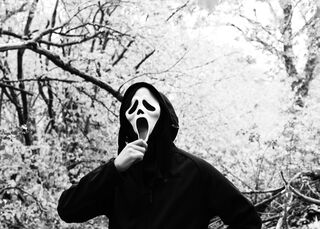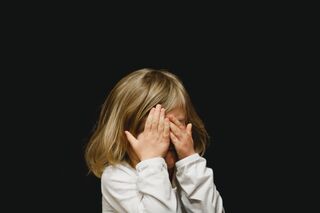Anxiety
How You Could Use Horror to Overcome Anxiety
Why watching horror is a good way to practice dealing with anxiety and fear.
Posted October 26, 2021 Reviewed by Vanessa Lancaster
Key points
- Anxiety is intrusive worrying that is difficult to control.
- Horror films reroute our anxiety to a monster or killer on the screen and give us control over the intensity of the threat.
- Horror films allow viewers to feel anxious in a safe setting and practice skills for regulating feelings of anxiety and fear.

Horror is probably the last genre that comes to mind when people think about how movies could help alleviate anxiety. Why would a genre whose entire purpose is to create fear and anxiety in the audience be helpful with anxiety?
The Basics of Anxiety
Anxiety is characterized by worry about a future event that may or may not occur. While we tend to think of anxiety as a negative feeling, a certain level of anxiety has been and continues to be adaptive. Anxiety motivates us to be vigilant toward threats and take pre-emptive action to prevent bad things from happening to us and those we care about.
Of course, a psychological feature that motivates responding to threats is prone to over-activation. This can be explained by something called the smoke-detector principle. The basic idea is that it is better for your smoke detector go off a few times when there is no fire than not go off when there is one.
In other words, the cost of a missed detection is much greater than the cost of several false detections. The same is true for anxiety. On average, it’s less costly to be vigilant about some potential threat and catch it ahead of time than it is to be blind-sided by it. Still, too many false detections can cause problems, and we see this manifest in the form of clinical anxiety.

Horror Gives us Control
Fear and anxiety are the core of the horror genre. At the center of every horror movie is a threat – a monster, a virus, a serial killer. The threats in horror hijack our brain’s attention system, drawing viewers in and immersing them in the movie. This works particularly well on anxious viewers because they are more vigilant toward potential threats.
Once the horror film begins, the viewer still feels anxious, but not about something in their life that they can’t control. Instead, the viewer’s anxiety becomes attached to the threat in the horror movie. This shift can benefit people with a generalized anxiety disorder who experience a sudden onset of anxiety with no source. The anxiety is still there, but it now has a face. This shift is also important because it allows the viewer more control over the intensity of the anxiety. If the anxiety is too much, the viewer can turn on the lights, watch during the daytime, cover their eyes during the scariest parts, or even look up the plot.
In addition to these behavioral measures, the viewer has an extra level of perceived control because they are now choosing to feel anxious by engaging with horror rather than being involuntarily subjected to anxiety. Importantly, the chosen anxiety has a definitive end. When the movie is over, the monster or killer on the screen who was the source of the anxiety fades away. At the end of the horror movie, the parasympathetic nervous system may even ramp up and give the viewer a feel-good sensation – they’ve overcome the threat.

Developing Long-Term Skills
For good reason, people often try to avoid anxiety and fear in their daily lives. However, bad things are bound to happen at some point or another, and those who are more practiced at dealing with feelings of fear and anxiety might be better equipped to deal with the situation.
One way to practice feeling afraid and anxious in a safe setting is to watch a horror film. Horror allows us to practice sitting with our feelings of anxiety and fear and learn how to regulate those feelings.
In many ways, engaging with horror films works like exposure therapy. By learning how to deal with feelings of fear and anxiety in a safe setting, horror fans might build long-term resilience skills that could be applied to novel situations.
My colleagues and I found evidence for this last year when we discovered that horror fans were more psychologically resilient during the pandemic. This finding even held when we controlled for many other factors, such as age, sex, income, and the Big 5 personality traits (Openness to Experience, Conscientiousness, Extraversion, Agreeableness, and Neuroticism).
Find What Works for You
The important thing to remember is that this would probably be best when you can achieve your “sweet spot” for fear. Watching a horror film that is too scary for you wouldn’t allow you to practice effective emotion regulation skills. Instead, find a horror film that is just at the edge of what you think you can handle. Find one where you’ll get a good scare but will still be able to enjoy the experience. Over time, you might find yourself able to handle scarier and scarier films – and maybe even scarier experiences in daily life.
References
Scrivner, C., & Christensen, K. A. (2021). Scaring away anxiety: Therapeutic avenues for horror fiction to enhance treatment for anxiety symptoms. https://doi.org/10.31234/osf.io/7uh6f
Scrivner, C., Johnson, J. A., Kjeldgaard-Christiansen, J., & Clasen, M. (2021). Pandemic practice: Horror fans and morbidly curious individuals are more psychologically resilient during the COVID-19 pandemic. Personality and individual differences, 168, 110397. https://doi.org/10.1016/j.paid.2020.110397




